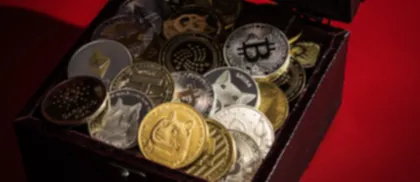Dec 3, 2020

Ethereum art(CoinDesk archives)
Muyao Shen
Why Ethereum and Bitcoin Are Very Different Investments
Those new to crypto, such as the institutional investors recently buying into bitcoin’s “digital gold” narrative, might now be looking around for the next big thing.
With the long-anticipated arrival of phase 0 of the Ethereum 2.0 upgrade launching on Dec. 1, that could be the network’s native token, ether (ETH). But analysts say ether should be judged on its own merits and not as a bitcoin replacement.
“I’ve always thought this digital asset space is huge – and it’s not just bitcoin – because there are going to be different applications for different things,” Raoul Pal, CEO and co-founder of financial media group Real Vision, said in Real Vision’s documentary “Ethereum – An Investigation,” which was released on Nov. 30. “I think of the two [bitcoin and ether] as having a very nice combined asset allocation.”
For Pal, an early bitcoin investor, the rationale seems even more plausible these days: As bitcoin’s price hits a new all-time high, the number one cryptocurrency by market capitalization is now more expensive and thus potentially a riskier bet for new investors.
It can be expected investors are looking for a new opportunity in crypto at affordable prices. Given that ether is trading roughly 59% below its all-time high of $1,432.88, it is tempting to believe there’s a bargain to be had. What’s more, the Ethereum 2.0 upgrade to increase the network’s scalability, security and energy efficiency has generated a lot of hype.
Read more: Investment Giant AllianceBernstein Now Says Bitcoin Has Role in Investors’ Portfolios
However, at least for now, analysts and traders who spoke with CoinDesk don’t think ether will replace the FOMO over bitcoin.
“For institutional investors, they are buying BTC for the digital gold narrative,” Ryan Watkins, senior research analyst at Messari, told CoinDesk. “ETH just isn’t in that conversation yet.”
Ether “benefits from spillover and likely has more conversation around it from crypto-natives,” Vishal Shah, founder of derivatives exchange Alpha5, told CoinDesk. “For the uninitiated, [it is] hard to see how bitcoin is not the sole on-ramp.”
Weakening correlation between bitcoin and ether
Some analysts say that as more institutions pour money into bitcoin and push up its price, ether and other cryptocurrencies will gradually decouple from bitcoin.
Indeed, while bitcoin this week logged a record high price, ether isn’t even close to its all-time high of $1,448.18. Data from CoinDesk shows the 90-day correlation coefficient between the prices of the top two cryptocurrencies, while still strong, has gradually weakened a bit since the summer from as high as 0.93 to nearly 0.7 at the beginning of December.

Source: CoinDesk Research
“The thing about correlation is it can disappear at any time,” Ashwath Balakrishnan, research analyst at digital asset research firm Delphi Digital, told CoinDesk. “In that case, you want to understand the core fundamentals of what you hold because if you hold ether as a proxy [to your] bitcoin exposure, and [when] prices decouple, you are now exposed to something very different.”
Bitcoin has been used by many investors this year as a hedge against a drop in the purchasing power of U.S. dollars. Ether is considered the currency of “the world computer,” which aims to build an ecosystem of decentralized applications.
The close historical correlation between bitcoin and other cryptocurrencies may be due to how tiny the digital-asset ecosystem is relative to the global economy. The total market capitalization of crypto assets is estimated at $562 billion, a mere 1.7% of the S&P 500 stock index’s combined market cap of $32.2 trillion. With almost every crypto asset built on different fundamentals, non-bitcoin cryptocurrencies may be trending with bitcoin prices simply because the nascent market is still so small and insular.
Read more: Volume Surge Brings 25% Turnover to ‘CoinDesk 20’
Correlation data doesn’t tell the whole story. Prices may move in tandem but the degree to which that happens is another matter. When the explosive decentralized finance (DeFi) boom hit the market during the summer, ether’s price rallied to its highest in more than two years because most DeFi projects are built on the Ethereum blockchain. At the time, bitcoin was struggling to break a similar two-year record.
What Ethereum 2.0 could mean for investors
The market will have to wait and see what kind of real impact the ongoing Ethereum upgrade could have on its native currency because the final phase of the process is scheduled to be completed in 2023. But a major fundamental upgrade on the network underpinning ether could lead its price to move on its own fundamentals, instead of merely following bitcoin’s price.
“The heart of ETH 2.0, which makes the entire system possible, is ether,” according to a report by Messari. “ETH will not only be Ethereum’s native store of value asset and fuel for transactions, but will also be Ethereum’s ultimate source of security from its role in the [proof-of-stake] system.”
Thus, while bitcoin can be seen as somewhere between a store of value and a commodity on the “asset superclass triangle,” ether could ultimately become the first asset to be a combination of all three classes of assets: capital assets, commodities and stores of value.
“When ether’s price starts to be driven by its own catalysts, holding it as a proxy to having BTC exposure will not work as expected,” Balakrishnan added.
READ MORE ABOUT...EthereumBitcoinEthereum 2.0
The leader in blockchain news, CoinDesk is a media outlet that strives for the highest journalistic standards and abides by a strict set of editorial policies. CoinDesk is an independent operating subsidiary of Digital Currency Group, which invests in cryptocurrencies and blockchain startups.













